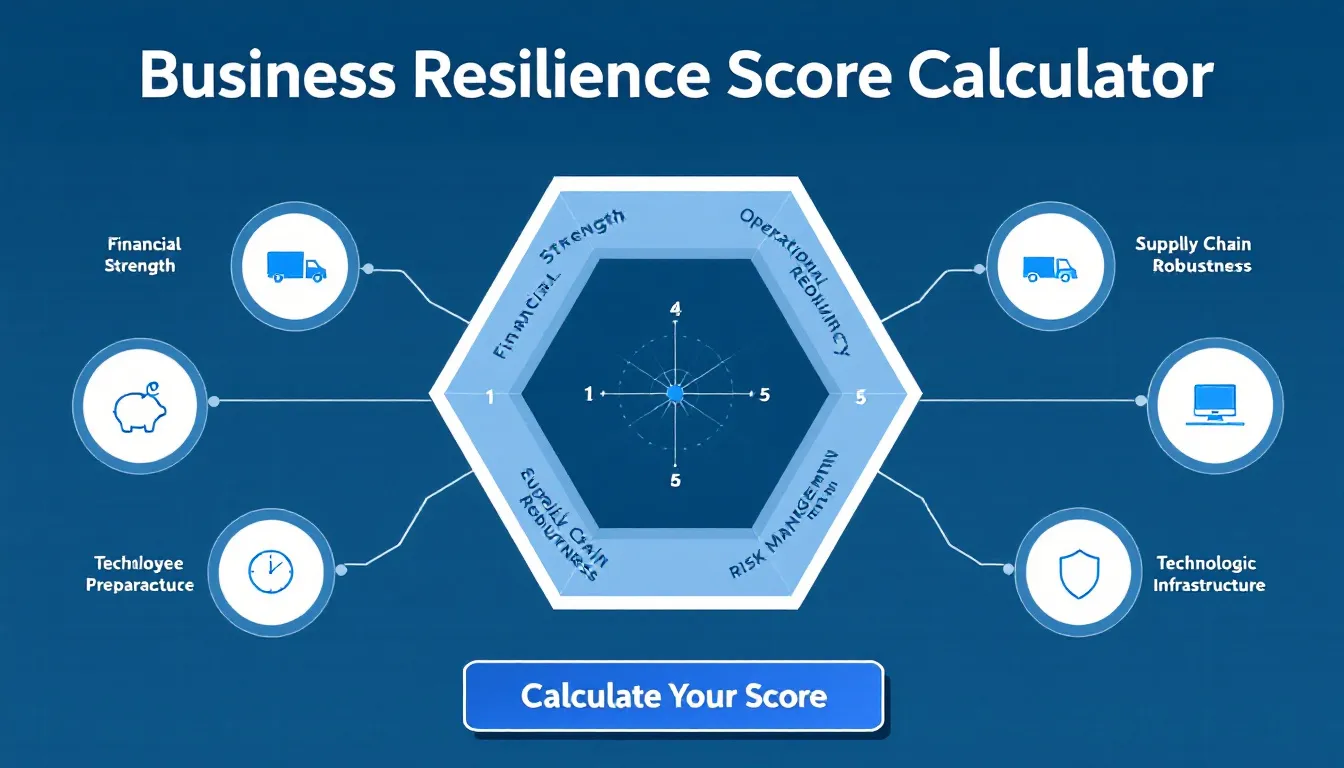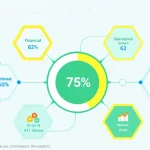Business Resilience Score Calculator
Is this tool helpful?
How to Use the Business Resilience Score Calculator Effectively
The Business Resilience Score Calculator is a powerful tool designed to help organizations assess their ability to withstand and recover from various disruptions. To use this calculator effectively, follow these steps:
- Financial Strength Score: Use the slider to rate your company’s financial health on a scale of 1 to 5. Consider factors such as cash reserves, profitability, and debt levels. For example, a company with strong cash flow and low debt might rate themselves a 4, while a company with inconsistent profits and high debt might choose 2.
- Operational Redundancy Score: Evaluate your backup systems and processes on a scale of 1 to 5. A company with multiple backup facilities and flexible workflows might select 5, whereas a company with limited redundancies might choose 2.
- Supply Chain Robustness Score: Assess the reliability and diversification of your supply chain from 1 to 5. For instance, a company with suppliers across multiple regions might rate themselves a 4, while a company heavily dependent on a single supplier might select 1.
- Employee Preparedness Score: Rate your workforce’s training and engagement in resilience plans from 1 to 5. A company with regular drills and clear communication plans might choose 5, while a company with minimal training might select 2.
- Technological Infrastructure Score: Evaluate your IT systems, including data backup and cybersecurity, on a scale of 1 to 5. A company with cloud-based backups and strong security protocols might rate themselves a 4, whereas a company with outdated systems might choose 1.
- Risk Management Practices Score: Assess your approach to identifying and mitigating risks from 1 to 5. A company with comprehensive risk assessments integrated into their strategy might select 5, while a company with informal risk management might choose 2.
After inputting all scores, click the “Calculate Resilience Score” button to generate your Business Resilience Score and receive tailored recommendations.
Understanding the Business Resilience Score Calculator: Definition, Purpose, and Benefits
The Business Resilience Score Calculator is an innovative tool designed to help organizations quantify and improve their ability to withstand and recover from unexpected disruptions. By evaluating six critical factors that contribute to organizational resilience, this calculator provides a comprehensive assessment of a company’s preparedness for various challenges.
Definition of Business Resilience
Business resilience refers to an organization’s capacity to anticipate, prepare for, respond to, and adapt to incremental change and sudden disruptions. It encompasses the ability to maintain core functions, protect assets, and ensure continuity of operations in the face of various threats, including natural disasters, economic downturns, cyber-attacks, and supply chain disruptions.
Purpose of the Business Resilience Score Calculator
The primary purpose of this calculator is to provide businesses with a quantitative measure of their resilience across multiple dimensions. By breaking down resilience into six key factors, the tool offers a nuanced understanding of an organization’s strengths and weaknesses in facing potential disruptions.
Benefits of Using the Calculator
- Comprehensive Assessment: The calculator evaluates six critical aspects of business resilience, providing a holistic view of an organization’s preparedness.
- Quantitative Measurement: By assigning numerical scores to each factor, the tool allows for objective comparison and tracking of progress over time.
- Identification of Weak Points: The breakdown of scores helps businesses identify specific areas that require improvement.
- Tailored Recommendations: Based on the scores, the calculator provides customized suggestions for enhancing resilience in areas of weakness.
- Strategic Planning: The results can inform strategic decision-making and resource allocation to bolster overall resilience.
- Stakeholder Communication: The visual representation of resilience scores can be used to communicate preparedness to stakeholders, including investors and regulators.
- Competitive Advantage: By improving resilience, businesses can gain a competitive edge in their industry.
The Mathematical Formula Behind the Business Resilience Score
The Business Resilience Score (BRS) is calculated using a simple yet effective formula that takes into account the six key factors of business resilience. Each factor is rated on a scale of 1 to 5, and the overall score is determined by taking the average of these ratings.
$$ BRS = \frac{F_1 + F_2 + F_3 + F_4 + F_5 + F_6}{6} $$Where:
- $$F_1$$ = Financial Strength Score
- $$F_2$$ = Operational Redundancy Score
- $$F_3$$ = Supply Chain Robustness Score
- $$F_4$$ = Employee Preparedness Score
- $$F_5$$ = Technological Infrastructure Score
- $$F_6$$ = Risk Management Practices Score
The resulting BRS will be a value between 1 and 5, which is then interpreted to determine the overall resilience level of the business.
Interpreting the Business Resilience Score
- 1.0 to 2.0: Low Resilience
- 2.1 to 3.0: Below Average Resilience
- 3.1 to 4.0: Moderate Resilience
- 4.1 to 5.0: High Resilience
How the Business Resilience Score Calculator Addresses User Needs
The Business Resilience Score Calculator addresses several critical needs for organizations seeking to enhance their preparedness and adaptability in the face of disruptions:
1. Quantifying Intangible Aspects of Business Resilience
One of the primary challenges in assessing business resilience is quantifying intangible aspects of preparedness. The calculator solves this problem by providing a structured framework for evaluating key factors on a numerical scale. This allows businesses to transform qualitative assessments into quantitative data, enabling more objective analysis and comparison.
2. Identifying Specific Areas for Improvement
By breaking down resilience into six distinct factors, the calculator helps businesses pinpoint specific areas that require attention. This granular approach allows for targeted interventions and resource allocation, rather than a one-size-fits-all approach to improving resilience.
3. Facilitating Informed Decision-Making
The calculator provides a clear, data-driven basis for strategic decision-making. By offering a comprehensive view of an organization’s resilience profile, it enables leaders to make informed choices about where to invest time and resources to strengthen their position.
4. Tracking Progress Over Time
The numerical scoring system allows businesses to track their progress in improving resilience over time. By regularly reassessing their scores, companies can measure the impact of their resilience-building initiatives and adjust their strategies accordingly.
5. Benchmarking Against Industry Standards
While the calculator doesn’t provide industry-specific benchmarks, it does offer a standardized framework that allows businesses to compare their resilience scores with peers or industry averages if such data is available.
6. Enhancing Stakeholder Communication
The visual representation of resilience scores, particularly through the radar chart, provides an effective tool for communicating resilience efforts to stakeholders. This can be particularly valuable when reporting to boards, investors, or regulatory bodies.
7. Promoting a Culture of Resilience
By engaging with the calculator and its results, organizations can foster a culture that values and prioritizes resilience. The process of assessment and improvement can help embed resilience thinking into day-to-day operations and long-term planning.
Practical Applications and Use Cases
The Business Resilience Score Calculator has a wide range of practical applications across various industries and business sizes. Here are some examples of how different organizations might use this tool:
1. Small Manufacturing Company
A small manufacturing company with 50 employees uses the calculator to assess its resilience. They input the following scores:
- Financial Strength: 3
- Operational Redundancy: 2
- Supply Chain Robustness: 2
- Employee Preparedness: 4
- Technological Infrastructure: 3
- Risk Management Practices: 2
The resulting Business Resilience Score is 2.67, indicating Below Average Resilience. The calculator recommends focusing on improving operational redundancy, strengthening the supply chain, and enhancing risk management practices. The company uses these insights to invest in backup production facilities and diversify its supplier base.
2. Large Financial Services Firm
A large financial services firm with 5000 employees conducts a resilience assessment using the calculator. Their scores are:
- Financial Strength: 5
- Operational Redundancy: 4
- Supply Chain Robustness: 3
- Employee Preparedness: 4
- Technological Infrastructure: 5
- Risk Management Practices: 5
The resulting Business Resilience Score is 4.33, indicating High Resilience. The calculator suggests minor improvements in supply chain management. The firm uses this information to review and enhance its vendor risk management processes.
3. Mid-sized Healthcare Provider
A mid-sized healthcare provider with 500 employees uses the calculator to assess its resilience in light of recent global health crises. Their scores are:
- Financial Strength: 3
- Operational Redundancy: 3
- Supply Chain Robustness: 2
- Employee Preparedness: 5
- Technological Infrastructure: 4
- Risk Management Practices: 4
The resulting Business Resilience Score is 3.5, indicating Moderate Resilience. The calculator recommends focusing on improving supply chain robustness and considering strategies to enhance financial strength. The healthcare provider uses these insights to implement a more robust inventory management system and explore options for improving their financial reserves.
4. Tech Startup
A fast-growing tech startup with 100 employees uses the calculator to prepare for potential challenges as they scale. Their scores are:
- Financial Strength: 4
- Operational Redundancy: 2
- Supply Chain Robustness: 3
- Employee Preparedness: 3
- Technological Infrastructure: 5
- Risk Management Practices: 2
The resulting Business Resilience Score is 3.17, indicating Moderate Resilience. The calculator suggests improvements in operational redundancy and risk management practices. The startup uses this information to implement cloud-based backup systems and develop a formal risk assessment process.
Frequently Asked Questions (FAQ)
1. How often should I use the Business Resilience Score Calculator?
It’s recommended to use the calculator at least annually, or more frequently if your business undergoes significant changes or faces new challenges. Regular assessments help track progress and identify emerging areas of concern.
2. Can the Business Resilience Score Calculator be customized for specific industries?
While the current version provides a general assessment applicable to most businesses, it’s possible to customize the factors or weightings for specific industries. Consider consulting with industry experts to tailor the tool to your sector’s unique needs.
3. How can I improve my company’s resilience based on the calculator results?
Focus on the areas where your scores are lowest. The calculator provides recommendations for each factor, which can serve as a starting point for improvement. Consider engaging internal teams or external consultants to develop targeted strategies for enhancing resilience in these areas.
4. Is a perfect score of 5 in all categories necessary for good business resilience?
While a perfect score would indicate excellent resilience, it’s not necessarily achievable or even desirable for all businesses. The goal is to achieve a balance that’s appropriate for your organization’s size, industry, and risk profile. Focus on continuous improvement rather than perfection.
5. How does the Business Resilience Score relate to other risk management tools?
The Business Resilience Score complements other risk management tools by providing a high-level overview of organizational resilience. It can be used alongside more detailed risk assessments, business continuity plans, and disaster recovery strategies to create a comprehensive approach to risk management.
6. Can small businesses benefit from using this calculator?
Absolutely. The principles of business resilience apply to organizations of all sizes. Small businesses can use the calculator to identify areas where they might be vulnerable and prioritize their efforts to build resilience, even with limited resources.
7. How does the calculator account for industry-specific risks?
The current version of the calculator focuses on general resilience factors applicable across industries. However, when rating each factor, you should consider the specific risks and challenges relevant to your industry. For a more tailored assessment, consider supplementing the calculator results with industry-specific risk analyses.
8. What should I do if my Business Resilience Score is low?
A low score indicates significant room for improvement in your organization’s resilience. Start by focusing on the lowest-scoring factors and implement the recommendations provided by the calculator. Consider seeking expert advice to develop a comprehensive resilience-building strategy.
9. How can I use the Business Resilience Score in communications with stakeholders?
The Business Resilience Score and its component factors provide a clear, quantitative way to communicate your organization’s preparedness to stakeholders. Use the radar chart to visually represent your resilience profile, and highlight the steps you’re taking to address any weaknesses identified by the assessment.
10. Can the Business Resilience Score predict how my company will perform in a crisis?
While a high Business Resilience Score suggests better preparedness for crises, it cannot predict exactly how a company will perform in a specific situation. The score is a tool for assessing overall resilience and identifying areas for improvement, but real-world crisis response depends on many factors, including the nature of the crisis and the decisions made in the moment.
Important Disclaimer
The calculations, results, and content provided by our tools are not guaranteed to be accurate, complete, or reliable. Users are responsible for verifying and interpreting the results. Our content and tools may contain errors, biases, or inconsistencies. We reserve the right to save inputs and outputs from our tools for the purposes of error debugging, bias identification, and performance improvement. External companies providing AI models used in our tools may also save and process data in accordance with their own policies. By using our tools, you consent to this data collection and processing. We reserve the right to limit the usage of our tools based on current usability factors. By using our tools, you acknowledge that you have read, understood, and agreed to this disclaimer. You accept the inherent risks and limitations associated with the use of our tools and services.







